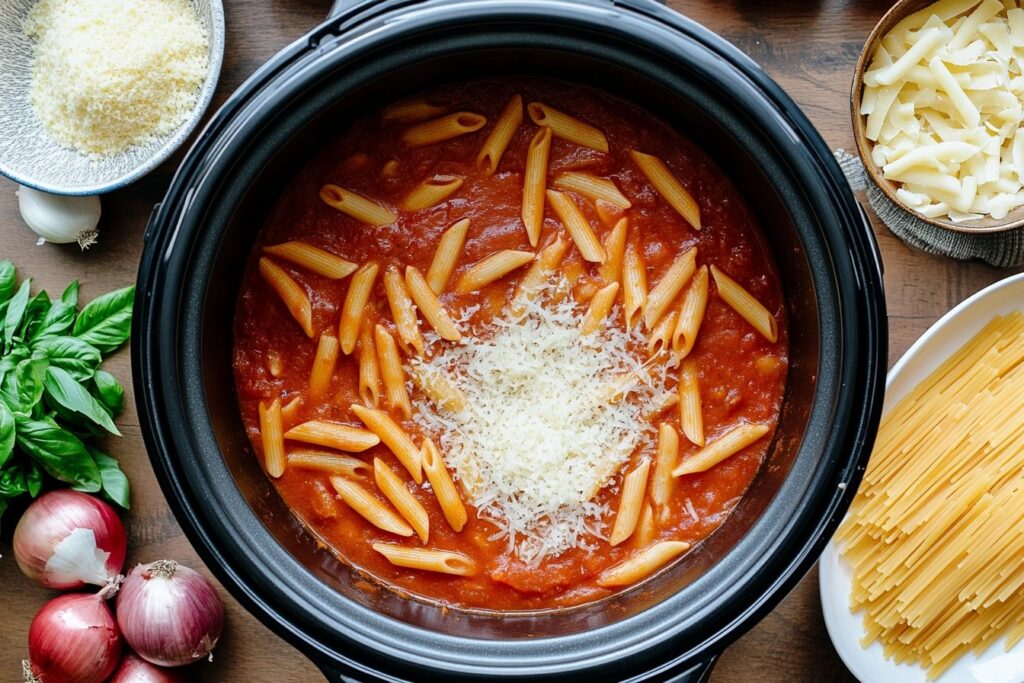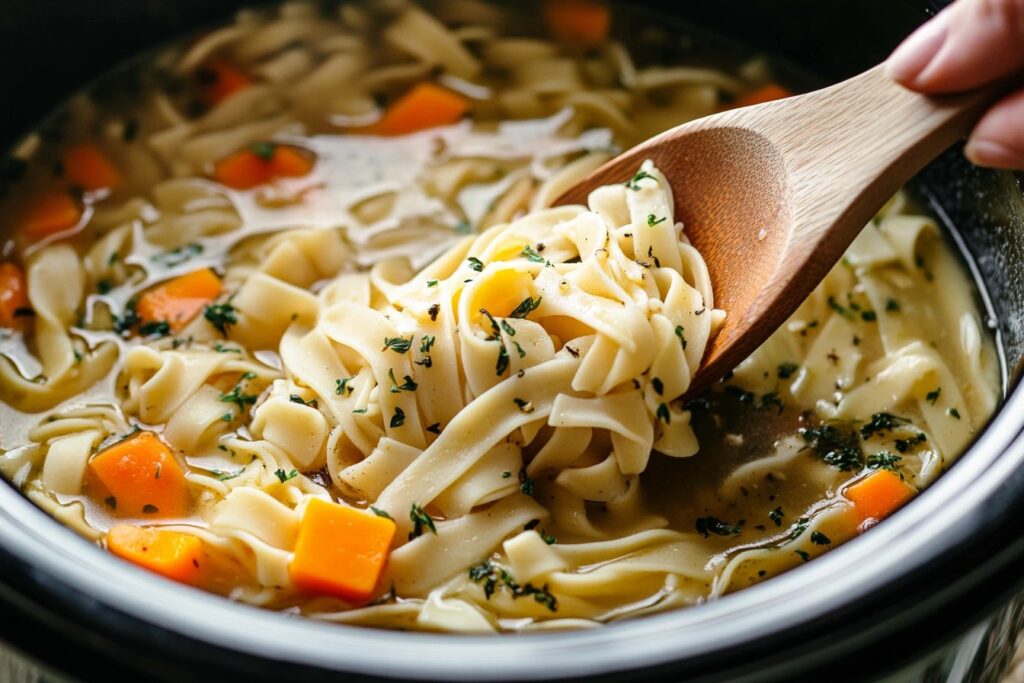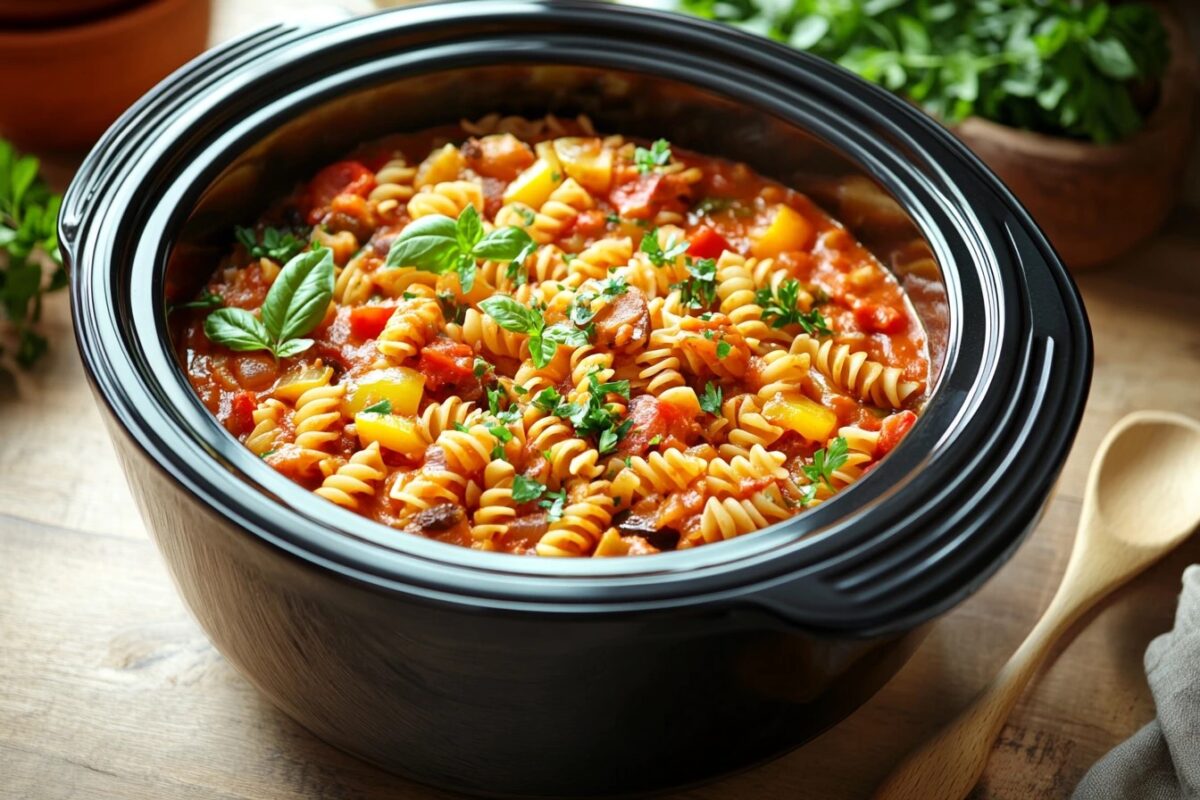Learn how to add dry noodles to your crockpot recipes with confidence.
Can I put dry noodles in the crockpot? Understanding the Basics
Many home cooks wonder, can I put dry noodles in the crockpot? Indeed, this question arises often, especially when looking for convenient ways to prepare hearty meals. Generally, crockpots transform tough cuts of meat and raw vegetables into tender, comforting dishes. Therefore, it seems logical to consider adding uncooked pasta to save time and dishes. However, before tossing those noodles in, it’s best to understand the process.
Basically, dry noodles can cook in a slow cooker, but they need special care. Comparatively, slow cookers use low, moist heat over many hours. Consequently, delicate noodles risk turning into mush if you add them too early. Conversely, with careful timing and proper liquid ratios, dry noodles can cook to a perfect al dente texture. Eventually, you will feel confident integrating them into your favorite one-pot meals.
Moreover, understanding your chosen noodles matters. For example, thin spaghetti differs greatly from thick egg noodles. Similarly, gluten-free or whole-grain noodles behave differently than regular pasta. Thus, the decision to add dry pasta into the crockpot depends on a few key factors. Ultimately, it’s about achieving the perfect texture, saving time, and ensuring your dish remains flavorful and satisfying.
Can I put dry noodles in the crockpot? Best Practices
When considering can I put dry noodles in the crockpot? you must follow best practices. Accordingly, start by selecting sturdy noodles. Equally, consider the recipe’s overall cooking time and liquid content. Another key point: noodles require sufficient moisture to cook properly. Therefore, ensure you have enough broth, sauce, or added water.
Furthermore, add your dry noodles near the end of the cooking cycle. Initially, let your meat, vegetables, and seasonings simmer for hours. Eventually, when the dish nears completion, stir in the uncooked pasta. Typically, about 20-30 minutes before serving allows noodles to absorb flavors without disintegrating. Comparatively, adding them at the start causes overcooking, resulting in a starchy mess.
Additionally, consider stirring occasionally while the noodles cook. Consequently, this prevents clumping and promotes even cooking. Likewise, taste test near the end. Basically, check if the noodles have reached the desired doneness. Adjust the seasonings if needed. Finally, remember that crockpot heat settings vary. Some run hotter, so timing may differ slightly. Altogether, patience and experimentation will guide you toward success.
Can I put dry noodles in the crockpot? Final Considerations
Before finalizing your approach to can I put dry noodles in the crockpot? understand that not all recipes suit this method. Therefore, consider the dish’s complexity. In some cases, precooking noodles separately may still prove best. However, if you crave convenience, adding dry noodles directly saves time and reduces cleanup.
Undoubtedly, once you master timing and texture, you can apply these principles to many recipes. Indeed, slow cooker soups, casseroles, and one-pot pastas can benefit from the direct addition of dry noodles. Another tip: adjust seasoning as the noodles absorb flavor. Comparatively, noodles may dull the seasoning slightly, so taste and season again at the end.
Eventually, by balancing moisture, timing, and noodle type, you’ll discover that using uncooked pasta in a crockpot is not only possible but practical. Ultimately, the slow cooker transforms into a versatile tool that produces comforting, family-friendly meals. With these considerations in mind, you can confidently add dry noodles to your crockpot creations.
Understanding How Noodles Cook in a Crockpot

Noodles thrive in environments with gentle heat and adequate moisture. However, a slow cooker’s low, steady heat can complicate matters. Comparatively, stovetop cooking involves boiling water that cooks noodles quickly. Meanwhile, in a crockpot, noodles take longer to soften.
Basically, noodles contain starches that expand as they cook. Therefore, cooking them for too long results in excess starch release. Consequently, this leads to a sticky, gluey texture. Conversely, careful timing ensures noodles remain tender yet firm. Initially, the crockpot’s gentle simmer lacks the rolling boil of a stovetop pot. Thus, noodles rely more on sauce or broth absorption to soften.
Eventually, understanding this difference helps you strategize. Hence, add noodles late and ensure there’s enough liquid. Additionally, remember that the thickness and shape of noodles influence cooking time. For example, thicker egg noodles require a bit longer than thin spaghetti. Furthermore, whole-grain noodles might hold up better due to their denser structure. Indeed, small adjustments in timing ensure success.
Factors Affecting Noodle Texture
When asking yourself can I put dry noodles in the crockpot?, consider multiple factors. Among these factors, cooking temperature and time rank highly. Accordingly, a higher heat setting cooks noodles faster but risks overcooking other ingredients. Conversely, a low setting extends cooking time, potentially causing noodles to become too soft if added prematurely.
Moreover, the type of noodles matters. Whole-wheat noodles often hold their shape better than regular pasta. Comparatively, gluten-free noodles may break down faster. Furthermore, shape influences texture. For example, shells or rotini might handle slow cooking differently than long strands of pasta. Thus, choose your noodle type wisely.
Additionally, the recipe’s liquid content plays a role. Essentially, noodles absorb a lot of liquid as they cook. Consequently, if your crockpot mixture is too thick, noodles may not soften fully. Conversely, if the dish is overly watery, noodles could become mushy. Therefore, monitor your liquid ratio and adjust accordingly. Eventually, find the sweet spot that delivers perfectly cooked noodles.
Adapting Recipes for Crockpot Noodles
To successfully integrate dry noodles, adapt your recipes. Initially, start with familiar dishes you know well. For instance, consider a classic chicken noodle soup. Normally, you would boil noodles separately. Now, try adding them directly toward the end. Consequently, with trial runs, you’ll learn how long to cook them.
Moreover, practice with small adjustments. If a recipe calls for 8 ounces of pasta, add slightly less at first. Basically, see how well it cooks, and then adjust next time. In addition, seasonings and herbs might need tweaking. Because noodles absorb flavors, you may want to add extra salt or spices at the end.
Eventually, you can tailor your favorite recipes for crockpot use. Another approach involves reading comments and tips from other home cooks. Many have tested methods and can guide you. Undoubtedly, shared knowledge from online communities helps you refine your approach. By doing so, you’ll confidently answer the question can I put dry noodles in the crockpot? with ease.
Avoiding Common Mistakes

When pondering can I put dry noodles in the crockpot? it’s equally important to know what not to do. Chiefly, avoid adding noodles at the beginning of a long cook time. Doing so ensures mushy, overcooked pasta. Instead, incorporate them near the end, when the other ingredients are almost done.
Another common mistake involves ignoring the liquid balance. Generally, noodles need enough liquid, but not too much. Add a bit of extra broth when stirring in dry noodles, especially if your dish looks thick. Likewise, avoid recipes without sufficient sauce. Comparatively, noodles can’t cook properly in a dry environment.
Additionally, do not rely solely on a set timer. Crockpots vary, so check for doneness. Taste a noodle before serving. If it’s too firm, cook a bit longer. Conversely, if it’s soft enough, stop cooking. Furthermore, remember that noodles will continue to soften slightly as they rest. Thus, serve promptly once they reach the desired texture.
Adjusting for Different Types of Noodles
When answering can I put dry noodles in the crockpot?, consider the noodle type. For example, egg noodles often feature in comfort foods like beef stroganoff or chicken noodle soup. Because they’re thicker and sturdier, they handle slow cooker conditions better. Conversely, delicate angel hair pasta may turn mushy more easily.
Additionally, thicker pasta shapes like penne or rotini might hold up well. Their firm structure can withstand slower cooking times. Meanwhile, specialty noodles like rice noodles or gluten-free options vary in texture. Therefore, test small batches first.
Moreover, consider partially cooking noodles before adding them. This approach might help delicate noodles maintain texture. Basically, boil them briefly, drain, and then finish cooking in the crockpot. This hybrid method offers more control. Eventually, you’ll learn which noodles work best and which require careful handling.
Flavor Considerations When Adding Dry Noodles
Noodles not only contribute texture but also soak up flavors. Accordingly, when adding dry noodles to the crockpot, think about seasoning. As noodles cook, they absorb broth and sauce, potentially diluting the dish’s flavor. Therefore, season generously at the start or be ready to adjust flavors before serving.
For example, if making a creamy chicken pasta dish, ensure the sauce is slightly more flavorful than usual. Eventually, noodles will even out the taste. Likewise, add fresh herbs or a sprinkle of cheese at the end to boost flavor. Comparatively, a dull dish can transform into something satisfying with final seasoning touches.
Furthermore, consider the dish’s overall balance. If the recipe includes lots of vegetables, noodles will integrate nicely. Conversely, if it’s meat-heavy, noodles might help stretch the protein and create a hearty one-pot meal. Basically, noodles can enhance or neutralize flavors, depending on your approach. Remember this when deciding how to season your crockpot meal.
Can I put dry noodles in the crockpot? and Timing
Can I put dry noodles in the crockpot? and Timing
When dealing with can I put dry noodles in the crockpot?, timing is crucial. Basically, add noodles about 20-30 minutes before you plan to eat. Add them too soon, and they become mushy. Add them too late, and they remain tough. Therefore, it’s best to start tasting them after 15 minutes. Eventually, you’ll develop a feel for perfect timing.
Additionally, consider the cooker’s temperature. On a high setting, noodles soften faster. Conversely, on low, they need a bit more time. Furthermore, if you’re unfamiliar with your crockpot’s quirks, experiment. Another tip: if you prefer firmer noodles, shorten the cooking time. On the other hand, if you like them softer, extend it slightly.
Can I put dry noodles in the crockpot? for Different Recipes
Can I put dry noodles in the crockpot? for Different Recipes
Not all recipes work equally well when adding dry noodles. For example, a simple soup or stew often welcomes this technique. Noodles thicken the dish and absorb savory broth. Conversely, a recipe with minimal liquid may not provide enough moisture for proper noodle cooking.
Additionally, consider dishes like lasagna-style casseroles. By layering noodles, sauce, and cheese, you can create a fuss-free baked pasta in your slow cooker. Basically, the slow heat allows noodles to absorb sauce, resulting in a comforting meal. However, ensure you use enough sauce. Another idea: for creamy pasta dishes, add a splash of milk or cream near the end to maintain richness.
Eventually, you’ll adapt many recipes for this method. Moreover, keep notes on how each pasta type performs in different recipes. Consequently, with practice, you’ll know exactly which dishes benefit most from adding dry noodles directly to the crockpot.
Can I put dry noodles in the crockpot? and Common Mistakes to Avoid
Can I put dry noodles in the crockpot? and Common Mistakes to Avoid
When experimenting with can I put dry noodles in the crockpot?, common mistakes can occur. Chiefly, as mentioned, adding noodles too early leads to a mushy texture. Another issue involves under-seasoning. Because noodles absorb flavor, failing to adjust seasonings leaves a bland dish. Therefore, taste before serving and tweak salt, pepper, or herbs.
Furthermore, don’t ignore the liquid ratio. If the crockpot mixture looks too thick, add extra broth before adding noodles. Conversely, if it’s watery, reduce liquid beforehand or add fewer noodles. Additionally, resist the urge to stir too often. While occasional stirring prevents clumping, constant agitation might break noodles apart. Indeed, a gentle hand ensures intact noodles.
Serving and Presentation Tips
When you’ve successfully answered can I put dry noodles in the crockpot? and achieved great texture, it’s time to serve. Presenting your dish attractively elevates the meal. Consider serving it in wide, shallow bowls. Garnish with fresh herbs, grated cheese, or a drizzle of olive oil. Consequently, small details make your meal visually appealing.
Moreover, serve the dish as soon as the noodles reach the right consistency. If you let it sit too long, noodles continue to absorb liquid and may turn softer. Therefore, timing matters even when serving. Another idea: pair the meal with crusty bread or a simple salad. Eventually, you’ll create a balanced, comforting dinner that pleases everyone.
Additionally, encourage diners to taste and season their portions. Everyone’s salt preference differs. By placing salt, pepper, and maybe some Parmesan on the table, guests can customize their dish. Thus, your crockpot meal becomes both convenient and flexible.
Health Considerations and Adjustments
When it comes to health, adding dry noodles directly to the crockpot can support portion control. Because noodles expand, a little goes a long way. Consequently, you can create a satisfying meal without excessive calories. Additionally, choosing whole-grain noodles adds fiber and nutrients. Thus, your dish becomes more balanced.
Moreover, consider low-sodium broths if monitoring salt intake. Another option: add more vegetables to the crockpot. As noodles cook, they blend with nutrient-dense produce, enhancing both flavor and healthfulness. Furthermore, lean proteins like chicken or turkey reduce overall fat. Comparatively, a simple pasta dish can evolve into a more complete, wholesome meal.
Eventually, by making mindful ingredient choices, you ensure that the convenience of adding dry noodles doesn’t compromise nutrition. Indeed, slow cooking allows for creative combinations. Therefore, keep experimenting until you find the perfect balance.
Storing and Reheating Leftovers
If you have leftovers, store them in an airtight container in the fridge. Because noodles absorb liquid over time, expect them to soften further. Therefore, when reheating, consider adding a splash of broth to restore moisture. Heat gently on the stovetop or microwave. Eventually, you’ll have a second meal that’s almost as good as the first.
Moreover, if you anticipate leftovers, slightly undercook noodles initially. In other words, leave them a tad firmer. Consequently, they won’t turn overly soft by the next day. Equally, avoid freezing dishes with fully cooked noodles. Freezing can alter texture, making noodles mushy upon thawing. Instead, freeze the noodle-free base and add fresh noodles when reheating.
Final Thoughts on Adding Dry Noodles
At this point, we’ve thoroughly addressed the question: can I put dry noodles in the crockpot? The answer is yes, but with careful planning. By timing the addition of noodles, adjusting liquid, choosing robust pasta shapes, and fine-tuning seasonings, you transform your crockpot into a pasta-making powerhouse.
Ultimately, this technique streamlines meal prep, reduces dishes, and delivers comforting, noodle-filled dishes with minimal fuss. Indeed, after some practice, you’ll know exactly how to achieve that perfect balance of convenience and taste. So, the next time you pull out your slow cooker, consider adding dry noodles. With the right approach, you’ll enjoy a hearty, delicious meal that saves time and effort.
Frequently Asked Questions
Can you put dried pasta in a slow cooker?
Yes, you can. Add dried pasta about 20-30 minutes before serving. Ensure enough liquid and stir occasionally to prevent clumping.
When should I add noodles to a slow cooker?
Add noodles near the end of cooking. Generally, about 20-30 minutes before the dish finishes. This ensures they cook to a firm, pleasing texture.
Why did my noodles turn to mush in the crockpot?
Overcooking causes mushiness. Adding noodles too early or using delicate pasta shapes leads to excess softness. Add them later and choose sturdier varieties.
Will pasta get mushy in the crockpot?
It can if cooked too long. However, by adding it late, adjusting liquid, and tasting for doneness, you can avoid mushy pasta.
